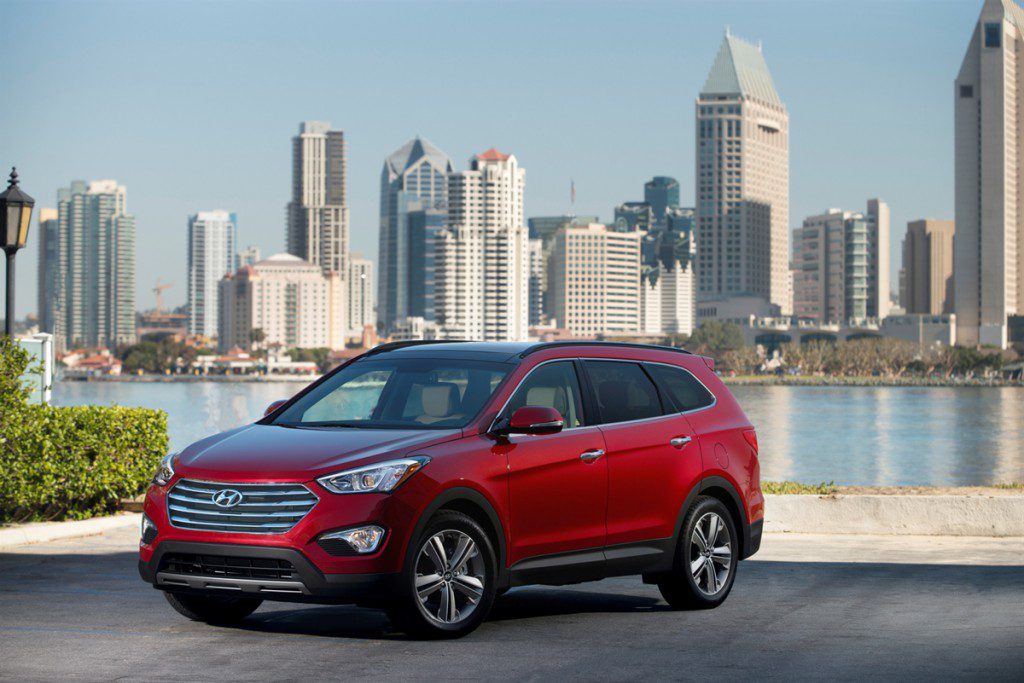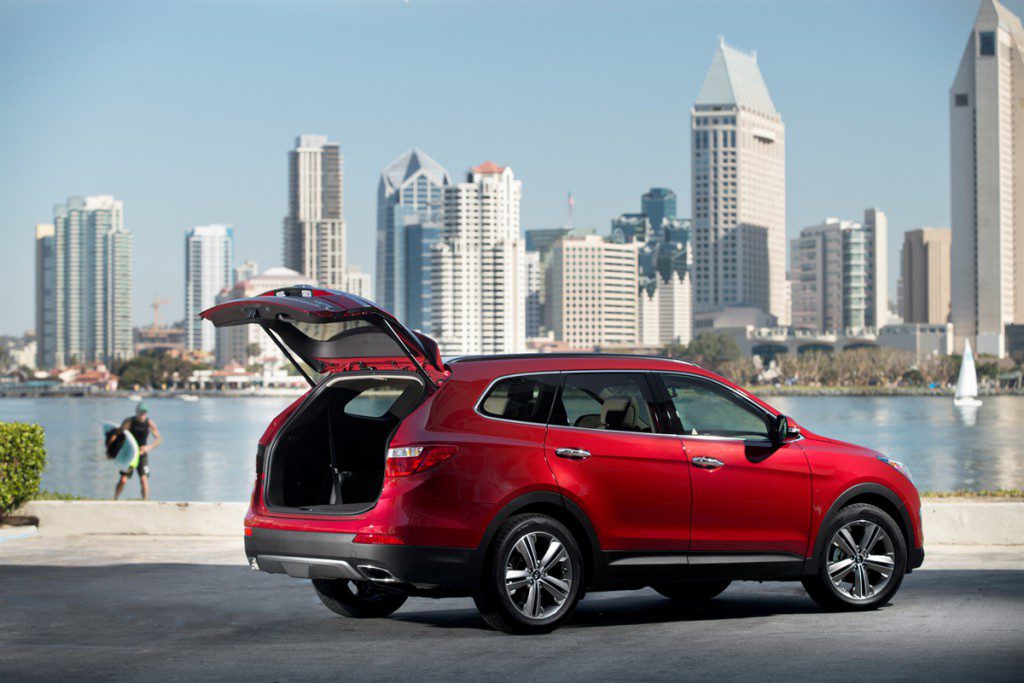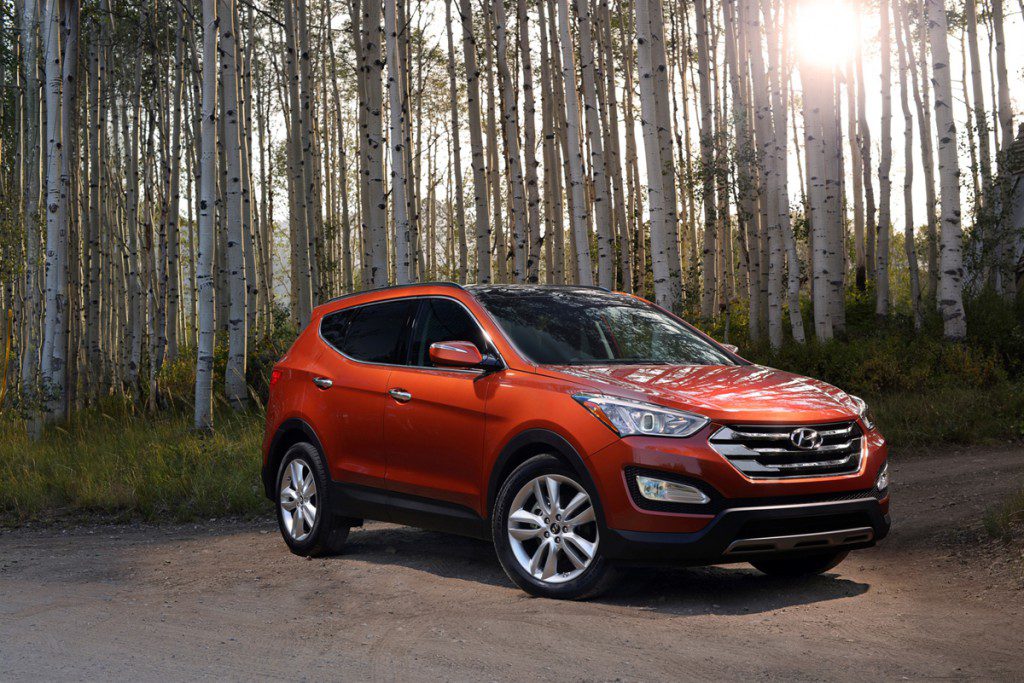With the Sport’s turbocharged engine, acceleration is fine from a stop, and there’s plenty of power for highway merging and passing. Throttle response is excellent and turbo lag is minimal. The automatic transmission is very smooth and well behaved. No 2.4-liter Sport models have been made available for testing. The Santa Fe’s 3.3-liter V6 is eager from rest and cruises smoothly and quietly at highway speeds. It, too, works well with the automatic transmission.
In Consumer Guide testing, a front-drive Sport 2.0T averaged 22.2 mpg. An all-wheel drive V6 model averaged 16.9 mpg with a 70% city and 30% highway mix. All models use regular-grade gas.
With the 2.0T model’s 19-inch tires, Santa Fe Sport has good bump absorption. Larger road imperfections are felt and rippled pavement can induce a bit of jiggling, but ride quality is comfortable overall. On the longer-wheelbase 3-row-seating models, there is little appreciable ride difference between the GLS with 18-inch wheels and the Limited with 19-inchers, though impacts with big surface irregularities transmit some shock.
All models include a “Driver Selectable Steering Mode” that uses a button on the steering wheel to adjust the amount of power steering assist. Comfort mode increases assist so the steering is very light. On the highway, the Comfort setting requires additional correction by the driver to maintain the chosen line. Sport mode reduces the assist so the steering requires a substantial amount of additional effort. The default Normal setting feels best with just enough power assist. Handling is fine for the class and Santa Fe Sport is responsive enough to inspire confidence. Braking is smooth with an easy-to-modulate pedal
Santa Fe Sport is very refined with excellent noise control. At a highway clip, the engine is nearly silent. A bit of wind rush is present above 60 mph, but it is far from intrusive. The GLS and Limited are subject to tire noise on some road surfaces.
Most controls are easy to use and well located. The available navigation system has a large display screen and is reasonably easy to program through touch-screen controls. Some audio controls are handled via the touch screen while others use physical buttons. Many functions are controlled via a series of buttons mounted on the steering wheel; there are enough of them that they will require a bit of acclimation. A control panel to the left of the steering wheel has buttons for several less-used systems including hill descent control and a lock button for the all-wheel-drive system. These can be hidden by the steering wheel. The dual-zone climate controls are well marked and easy to use. The large gauges are clearly marked. For the most part they are easy to read, but while wearing polarized sunglasses, two of the smaller display screens weren’t lit as brightly as the rest of the cluster, making them difficult to decipher at a glance.
Santa Fe Sport’s cabin is tastefully finished. The available leather upholstery looks nice. Larger plastic panels are finished in an assortment of visually interesting textures. Some smaller areas carry a metallic gray paint finish. Accents vary by interior color. For example, black cabins have dark smokey-colored simulated wood and the gray interior comes with dark gray panels with a silver cross-hatch pattern. Many interior panels are padded, but there are some hard plastic pieces as well. The seat fabric standard in the GLS and base Sport has a nice look and feel. Soft-touch textured surfaces on the instrument panel of the Limited added color contrast to the interior and harmonized with the color of the leather seats.
Up front, all Santa Fes are very comfortable with plenty of legroom. Under the available sunroof, headroom is good even for six footers. The seats are comfortable with good support, but the long legged may wish the bottom cushions were a bit longer. Only the driver’s seat is height adjustable. The standard tilt and telescopic steering wheel makes it easy to fine tune your driving position. Front pillars can limit visibility in sharp turns. Visibility to the rear corners in the Sport is limited due to small quarter windows. This is less of a problem in 3-row Santa Fes, but if 3rd-row headrests are left in the up position, straight-back vision is reduced. Entry and exit are easy.
Six footers will find adequate legroom and foot space in the 2nd row, even behind a front seat passenger of the same size. Headroom under the sunroof is good in Sports and even slightly better in the GLS and Limited. In Santa Fe Sports with leather upholstery and all 3-row models, 2nd-row seats recline and slide fore and aft, but moving them forward quickly eats away at the available legroom. In Limiteds, children or smaller adults can pass between the captain’s chairs to the 3rd row; otherwise 2nd-row seats slide forward for access. Third-row seating is low, cramped, and best left to youngsters. Again, entry and exit are easy.
Good cargo space behind the back seat in Sports. When the available sliding rear seat is moved forward, it leaves a large gap between the seat and the load floor. The seat back is split 40/20/40 which makes for plenty of cargo-carrying options. The rear seat sections flip forward easily (models with leather upholstery include handy releases in the cargo bay), but the headrests can hit the front seats if the latter are pushed fully back. The resulting load floor is smooth, but it runs uphill a bit towards the front. There are two underfloor storage compartments hidden beneath lift-up panels. The smaller one is just inside the tailgate; it houses the jack and a small cargo bin. The larger compartment has a molded organizer that divides it into smaller sections. In 3-row models, a pull of a cord on the 3rd-row seat back quickly folds it to create a large, flat load floor. Captain’s chairs in the Limited fold down out of the way, but don’t lie flat and leave gaps between the seats. The cabin’s small-item storage is good. All four doors have map pockets with bottle holders, there’s a big bin in front of the shifter, and there’s a nice compartment under the center arm rest. There are additional cup holders on the center console and in the 2nd-row bench seat’s fold-down center arm rest.




